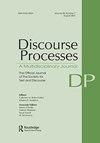Comprehending irony in text: evidence from scanpaths
IF 2.1
2区 心理学
Q2 PSYCHOLOGY, EDUCATIONAL
引用次数: 0
Abstract
Eyetracking studies have shown that readers reread ironic phrases when resolving their meaning. Moreover, it has been shown that the timecourse of processing ironic meaning is affected by reader’s working memory capacity (WMC). Irony is a context-dependent phenomenon but using traditional eye-movement measures it is difficult to analyze processing beyond sentence-level. A promising method to study individual differences in irony processing at the paragraph-level is scanpath analysis. In the present experiment, we analyzed whether individual differences in WMC are reflected in scanpaths during reading ironic stories by combining data from two previous eye-tracking studies (N = 120). The results revealed three different reading patterns: fast-and-linear reading, selective reading, and nonselective rereading. The readers predominantly used the fast-and-linear reading pattern for ironic and literal stories. However, readers were less likely to use the nonselective rereading pattern with ironic than literal texts. The reading patterns for ironic stories were modulated by WMC. Results showed that scanpaths captured differences missed by standard measures, showing it to be a valuable tool to study individual differences in irony processing.理解文本中的反讽:来自扫描路径的证据
眼球追踪研究表明,读者在理解反讽短语的意思时,会重读它们。此外,研究还表明,反讽意义加工的时间过程受读者工作记忆容量的影响。反语是一种语境依赖现象,但传统的眼动测量方法难以分析句子层面以外的加工过程。扫描路径分析是研究段落反语加工个体差异的一种很有前途的方法。在本实验中,我们结合之前两项眼动追踪研究(N = 120)的数据,分析了阅读讽刺故事时WMC的个体差异是否反映在扫描路径上。结果显示了三种不同的阅读模式:快速线性阅读、选择性阅读和非选择性重读。读者主要使用快速和线性阅读模式来阅读讽刺和文字故事。然而,与字面文本相比,读者不太可能使用非选择性重读讽刺文本的模式。反讽故事的阅读模式受WMC的调节。结果表明,扫描路径捕捉到了标准测量所遗漏的差异,表明它是研究反语加工个体差异的一种有价值的工具。
本文章由计算机程序翻译,如有差异,请以英文原文为准。
求助全文
约1分钟内获得全文
求助全文
来源期刊

Discourse Processes
Multiple-
CiteScore
4.30
自引率
4.50%
发文量
27
期刊介绍:
Discourse Processes is a multidisciplinary journal providing a forum for cross-fertilization of ideas from diverse disciplines sharing a common interest in discourse--prose comprehension and recall, dialogue analysis, text grammar construction, computer simulation of natural language, cross-cultural comparisons of communicative competence, or related topics. The problems posed by multisentence contexts and the methods required to investigate them, although not always unique to discourse, are sufficiently distinct so as to require an organized mode of scientific interaction made possible through the journal.
 求助内容:
求助内容: 应助结果提醒方式:
应助结果提醒方式:


